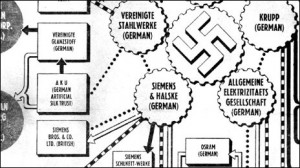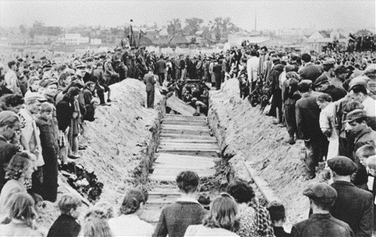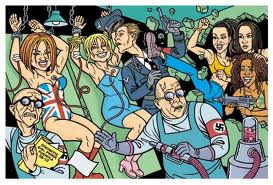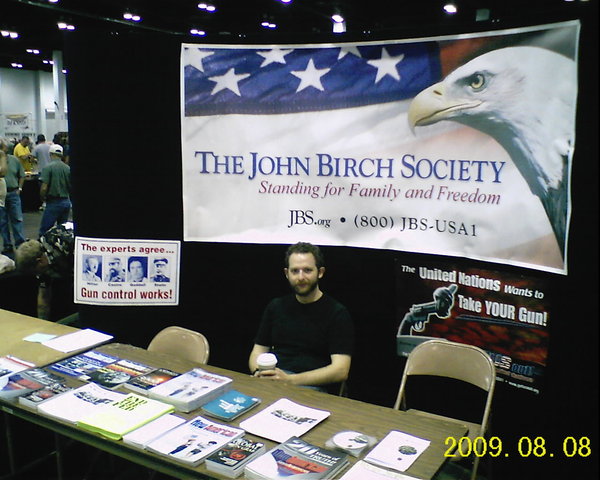Alex Constantine - September 25, 2013
Photo: CONCENTRATION CAMP - The factory system at Monowitz-Buna, a part of the Auschwitz system, used slave workers to produce synthetic rubber and oil. Credit: Bundesarchiv, Bild 146-2007-005
From Chemistry & Englineering News
Volume 91 Issue 37 | pp. 30-33
September 16, 2013
The German Chemical Society played a central and often willing role in Third Reich ventures, a new history reveals
Eighty years ago, Adolf Hitler came to power in Germany. The country’s dark 12-year National Socialism (Nazi) era began, and its intolerance of Jews, Roma, people with disabilities, Communists, and homosexuals led to incarceration in concentration camps and death, often from slave labor or in gas chambers. By the end of World War II, some 60 million civilians and soldiers had died worldwide.
Chemistry was central to Nazi endeavors. As the country became increasingly isolated from raw materials, chemists played a major role developing and improving techniques for producing synthetic alternatives to rubber, petrol, and even coffee. Chemical expertise was required to set up and run factories for these products. At Monowitz-Buna, part of the Auschwitz concentration camp system, the conglomerate company IG Farben, which included BASF, Bayer, Agfa, and Hoechst, used slave workers to produce synthetic rubber and oil. Average life expectancy for these workers was just a few months. The IG Farben conglomerate also produced the pesticide Zyklon B, which was used in gas chambers.
These and other details emerged in 1946 and 1947 during the trials in Nuremberg for Germany’s most nefarious war criminals. But the role of many German chemists was subsequently buried, revised, whitewashed, or denied as the country focused on rebuilding after the war, says Helmut Maier, a historian of technology at Ruhr University, in Bochum, Germany.
Upon request of the German Chemical Society (GDCh), Maier has just completed a six-year analysis of the society’s history in Nazi Germany, resulting in a 700-page tome that was delivered to GDCh this month and will be sent to potential publishers this fall. His work confirms and extends earlier research by Ute Deichmann, a historian of science at Ben-Gurion University of the Negev, in Israel, on the expulsion of Jews from science institutes and the activities of academic chemists during the Third Reich.
In combination, their research reveals that the two chemical societies that joined after World War II to become GDCh were both eagerly compliant with Aryanization—advancing the superiority of the Aryan “race”—and dismissed Jewish members, society leaders, and staff, even before Nazi laws required them to do so. Before and during the war, the two chemical societies actively sought out collaborations with the Nazi military complex and supported the Third Reich by coordinating military research, publishing top-secret journals on poison gas and how to develop synthetic products without access to many raw materials. Finally, when the war ended, high-profile chemists wrote letters defending the character of IG Farben chemist and executive Carl Krauch, even after he had been found guilty of crimes against humanity.
When Hitler came into power in 1933, Germany’s chemical industry was responsible for about 20% of the country’s national income, Maier says. There were some 15,000 chemists in the country, many of whom were members of Germany’s two major chemical associations. The 4,000-member association of academic chemists from Germany and abroad (DChG) published important internationally read publications such as the “Beilstein Handbook of Organic Chemistry.” Meanwhile, VDCh, a second association, represented more than 10,000 German industrial chemists and published the precursor to the current-day journal Angewandte Chemie.
In 1933, four out of the six German Nobel Laureates in chemistry were of Jewish descent—Adolf von Baeyer, Fritz Haber, Otto Wallach, and Richard Willstätter. Several high-profile members of the academic association DChG were also Jewish: the society’s president, Alfred Wohl; its vice president, Arthur Rosenheim; and the long-time editor of the “Beilstein Handbook,” Bernhard Prager. Within months of Hitler’s ascension, all three “were asked to tender their resignations,” Deichmann notes, as were six Jewish staff members of the “Beilstein Handbook.” It was an example of “anticipatory obedience,” she says, given that they were not legally required to do so. In addition, as early as 1935, both societies rejected new-member applications from Jewish or half-Jewish chemists, Maier says, and began expunging existing Jewish members.
DChG board members tried to hide their early adoption of Aryan ideals from international members, who they realized would object to the behavior. From board meeting records, Maier found that the association’s leadership adopted a strategy “to Aryanize in an opaque way, to avoid showing it to the public,” he adds.
This was because international membership represented 40% of the society, and DChG relied on international membership fees and journal subscriptions. In particular, in the early 1930s, Germany was on the wrong side of a trade imbalance, and the country needed foreign currency to equalize it, Maier says. International subscriptions could help correct the imbalance. Furthermore, in the 1930s, part of the Nazi mission was to propagate an image of German excellence, including the excellence of German science. Losing international membership would be akin to losing face.
VDCh also rapidly adopted Aryanization policies, dismissed Jews, and added pro-Nazi wording to its mission statement.
Aryanization was also widely adopted in academic circles. Between 1933 and 1938, a quarter of all chemists and biochemists in academic institutes throughout Germany and Austria lost their jobs. Ninety percent of these dismissals were for racial reasons: Dismissed employees were either Jewish, non-Jews with Jewish ancestry, or married to a Jew, Deichmann says. The remaining 10% involved other people the regime found untenable.
“It is one of the most notable phenomena in academia in 1933 that the severest measures of National Socialist policies against science were carried out under a high degree of silence and with the frequent consensus of scientists,” writes Deichmann in a review of chemistry during the Nazi era (Angew. Chem. Int. Ed.2002,41, 1310). She has found only a single instance in which a German scientist refused to accept a new position created through the dismissal of a Jewish scientist.
This silence regarding the unfair dismissal of Jewish colleagues was common across most fields of science, and it stemmed from some combination of anti-Semitism, nationalism, cowardice, obedience, or opportunism, Deichmann says. The vacant positions were often taken by young scientists who may not have had comparable academic career opportunities had anti-Jewish policies not cleared the way. Perhaps for this reason, Deichmann notes, 63% of young scientists joined the Nazi Party, a larger percentage than the 53% of chemists and biochemists of all ages who joined.
A scientist did not have to be a Nazi Party member to behave badly. “You find examples of people who never joined a Nazi organization but did horrible things,” says Mark Walker, a historian of science at Union College in Schenectady, N.Y.
Consider the case of Nobel Laureate Richard Kuhn, president of DChG during the war and a man who never joined the Nazi Party. As soon as Hitler came to power in 1933, Kuhn immediately dismissed all his Jewish subordinates at the Kaiser Wilhelm Institute for Medical Research, where he was head of the chemistry department, Deichmann says. In 1936, he spontaneously denounced his colleague Otto Meyerhof, who was still employing Jewish scientists. From the beginning of the Third Reich, Kuhn also began to pepper his speeches at home and abroad with “Sieg Heil,” even at non-Nazi functions. When he won the Nobel Prize in 1938 for his natural product research, Kuhn rejected the prize with a letter punctuated with his handwritten addendum: “The Führer’s will is our belief.” During the war, Kuhn also did extensive research on the toxic nerve gases tabun and sarin and invented a poison gas called soman.
Meanwhile, DChG secretly coordinated research and published a top-secret journal on war-related chemistry, focusing on such topics as poison gases, polymers, and the development of synthetic products, Maier says. Called the Reich Berichte (Reich Reports), the secret journal was handed from one researcher to another. Every reader had to sign when receiving the journal and when passing it along. In addition, during the war, journal editors went on trips into occupied territories, where they looted research institutes of equipment, journals, and staff for use in military research.
Academic chemists in DChG did fight back against the regime in one way: They heavily objected to being integrated into NSBDT (National Socialist German Technical Association), a Nazi umbrella organization for science and technology. The reason? NSBDT was mostly made up of engineering organizations, and the chemists felt that as natural scientists they were superior to engineers, whom they perceived to be a lower caste of scientists, Maier says. As part of this superiority complex, they got into conflict with top Nazi power brokers, including deputy Nazi Party head Rudolf Hess. “Chemists fought no battles for Jews,” Maier says. “They fought no battles for immigrants. They only fought a battle against becoming involved in this engineering society—a battle for their professional interests.” They eventually lost the fight and were forced to join NSBDT, but their resistance reveals “the society had huge latitude. They had free range,” Maier says.
What chemists did was mirrored in the rest of Germany’s scientific community. “Chemists received a lot of support for their research” from the Nazi regime, Deichmann says. “But I am not sure we can say they were more opportunistic than other” scientists. Comparable percentages of biologists, psychologists, and chemists joined the Nazi Party, she says. The German Biological Society, for example, had a journal called Der Biologe (The Biologist) that was entirely full of Nazi ideology, and psychologists and biologists participated in terrible human experiments, she adds.
The German Physical Society was, however, much slower than most other science societies to exclude all Jews from membership, says Klaus Hentschel, a science historian at the University of Stuttgart. The physicists did not exclude Jews until 1938 to 1939, and only under pressure from Nazi authorities, he adds. The German Physical Society also avoided joining NSBDT. “You can say what wonderful people these physicists were,” Hentschel says, but in truth, they had many motivations that were not necessarily more ethically superior to those of other scientists. For example, they also resisted joining the Nazi society made up of engineers, on the basis of the same superiority complex chemists had, Hentschel explains.
Unraveling The Germany Chemical Society’s Nazi History
During the course of Helmut Maier’s six-year study of GDCh’s Nazi history, he consulted more than 20,000 pages of documents, including
10,000 pages of documents at the Bayer archive in Leverkusen
5,000 pages of documents in the GDCh archive
4,000 to 5,000 pages from the Berlin government archive
1,000 pages from a Russian archive in Moscow
Nearly 1,000 pages from a former IG Farben photochemical plant
SOURCE: Helmut Maier
Also, “physicists benefit from the fact that initially they were just not seen as that important” to the regime, Walker says. “Engineering and chemistry were more relevant than physics and mathematics to Nazi goals,” but as the war progressed, physicists increasingly did military research in such areas as missiles, sonar, and nuclear weapons.
After the war ended and international scientists began asking pointed questions about the activities of their German colleagues, Maier says, German researchers increasingly adopted a false narrative that they had suffered under Hitler, despite their flush funding under the Third Reich. “They would say the Nazis were anti-intellectual, antiscientific, and anti-basic research,” he says. “This is absolutely false.” The Third Reich “was a paradise for these scientists, compared to the situation up to 1933, when there were many cutbacks” because of financial constraints imposed by the terms of the Treaty of Versailles, which ended World War I.
Many chemists claimed they didn’t know what had been happening at Auschwitz’ Monowitz-Buna factory and at other concentration camps. “But how can you get such a large chemical factory established and running smoothly without any chemists present?” Maier asks. Kuhn, for instance, may not have personally visited any concentration camps, but as director of the Kaiser Wilhelm Institute for Medical Research and president of DChG throughout the war, he was certainly privy to some aspects of Hitler’s human experimentation, Deichmann notes.
Some chemists claimed to have spent the war doing pure research, “but if you look carefully, you see it was definitely military research,” Maier says. “They would say, ‘I was just working on metal carbonyls,’ ” Maier says. But metal carbonyls can disable the gas mask filters soldiers used as protection, he adds. Other chemists involved in military research repurposed their discoveries for civilian purposes postwar. For example, Kurt Stantien, a Nazi Party member since 1925, spent the war developing a device to uniformly spray poison gas on enemy soldiers. The device was turned into a pesticide delivery system for agricultural applications in the 1950s, Maier says.
Finally, many scientists claimed they were victims during the postwar period, saying the Allies were implementing unfair Siegerjustiz, or victor’s justice, Maier says. They even banded together to show support of IG Farben chemists and board members on trial in Nuremberg. For example, Deichmann notes that after the Nuremberg trials DChG officials wrote a letter to the head of the American zone of occupation in postwar Germany, complaining about harsh sentences for IG Farben executives: “We do not understand the severity of the prison sentences imposed on men who, in our opinion, are in this way unjustly made comparable to common criminals. We cannot believe from our knowledge of the convicted that dishonorable thought or deeds have really been proven against them.”
After the war, “the Allies were threatening severe punishment. Everyone was afraid of that,” Hentschel says. “Everyone had a conspiratorial mood, not speaking about [the past] openly, so the Allies wouldn’t get any clues about what was really going on. Many documents were burned.”
Indeed the Allies, and particularly the Americans, did not always behave with moral integrity or with transparency in Germany’s postwar period. Keen to profit on sophisticated Nazi military and industrial science and technology and afraid it might fall into the hands of the Russians, their new Cold War enemy, the U.S. military established Operation Paperclip. When interviewing Nazi scientists after the war, Army officials would put a paper clip on the portfolios of those scientists who could be useful to the American military, Deichmann says. Those individuals would then have their Nazi affiliations whitewashed, new biographies written, and a security clearance and ticket to the U.S. issued. “It was so completely immoral,” Deichmann says.
The most famous beneficiary of Operation Paperclip was Werner von Braun, who headed Nazi missile research, was a Nazi Party member, and then went to work for the U.S. National Aeronautics & Space Administration after the war. His expertise is widely cited as one reason U.S. astronauts were the first to reach the moon. Maier has also tracked down a dozen names of Nazi-era chemists who went to work in the U.S., for example, on chemical weapons for the U.S. Army and in a synthetic fuels lab at the U.S. Bureau of Mines.
Many other scientists in Germany went through denazification, a process in which the ethics of one’s wartime behavior was evaluated and sometimes cleared or whitewashed through letters of support from colleagues or friends. For those deemed to be Nazis, the denazification process resulted in brief jail time or a fine, as in the case of Karl Merck, chairman of the VDCh board up to 1942, Maier explains. There were “people pretty badly caught in the National Socialism system with a lot of dirt [on them] who were in the end coming out of the denazification procedure with a fee or half a year of prison,” Hentschel says.
Many of the first historians trying to probe science under the Nazis during the 1980s faced pushback from those who preferred to let sleeping dogs lie. For example, researchers loyal to an electrical engineer whom Maier discovered to be a Nazi threatened to sue him. And supporters of Kuhn succeeded in launching a university investigation against Deichmann about the veracity of her research on Kuhn’s behavior during the Nazi era. She was eventually cleared.
Studying Germany’s Nazi history became a more acceptable mainstream historical topic in Germany in the 1990s, Deichmann says. At that point, large institutions in the country began to ask historians to investigate their institutional histories during the Third Reich. These institutions included the country’s largest funding agency, the German Research Foundation, and the Max Planck Society and its 80-plus institutes, which evolved out of the Kaiser Wilhelm Society, its name during the Third Reich.
Getting approval to write institutional histories requires the approval of board members, which was not initially possible while former Nazis still held powerful positions in many scientific organizations.
In the mid-2000s, when former president of GDCh Henning Hopf instigated a plan to have Maier investigate GDCh’s Third Reich history, he received complaint letters about the proposal from the society’s membership. The society had already experienced backlash from its earlier decision to remove a prize in Kuhn’s name after Deichmann’s work revealed his Nazi past.
However, an institutional history of the chemical society was overdue, says Wolfram Koch, executive director of GDCh. “When somebody asks, ‘What did your society do during the National Socialism era?’ ” Hopf says, “it is unacceptable nowadays to answer, ‘I don’t know.’ ”








